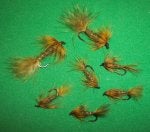Lionsfan96
New member
Hi all. This is my first post on a forum. I was wanting to get into tying and fishing soft hackles. Any patterns or tips for a beginner?
Sent from my SM-N960U using Tapatalk
Sent from my SM-N960U using Tapatalk
Best advice you can get! Dave Hughes also has a book on soft hackles and wet flies that is very good.
It depends on what species of fish you are pursuing and where. The books mentioned are primarily about trout in rivers, but soft hackles are also effective for some warm water species in Lakes.Any patterns or tips for a beginner?
Sent from my SM-N960U using Tapatalk
Dillon makes a good point. Soft hackles are one of my most productive patterns for trout in lakes, especially in the mornings and evenings. Often the trout you see splashing really are taking emergers just under the surface.It depends on what species of fish you are pursuing and where. The books mentioned are primarily about trout in rivers, but soft hackles are also effective for some warm water species in Lakes.
Mainly trout in the lower illinois river in oklahoma.It depends on what species of fish you are pursuing and where. The books mentioned are primarily about trout in rivers, but soft hackles are also effective for some warm water species in Lakes.


